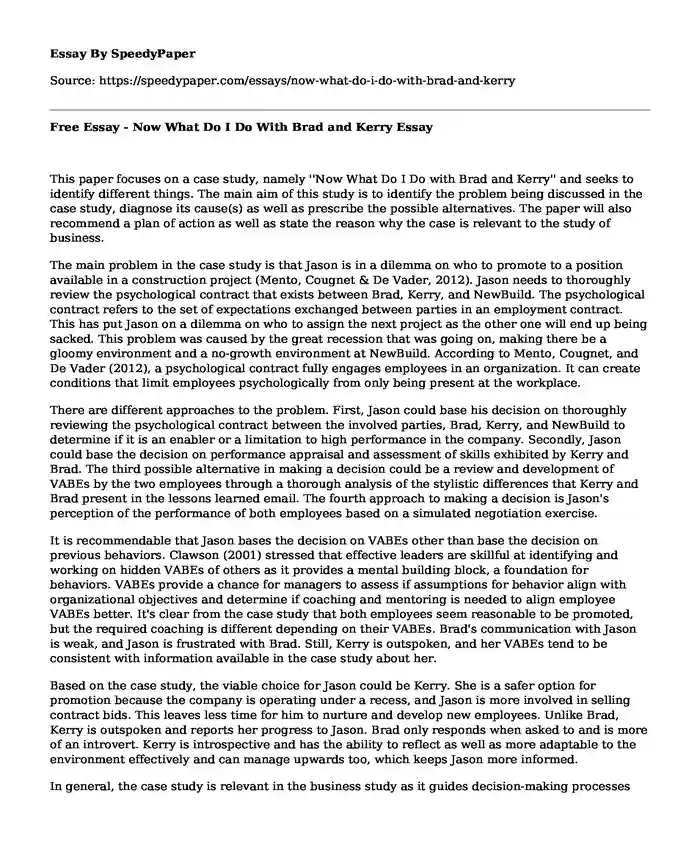
| Type of paper: | Case study |
| Categories: | Business Job Case study Organizational behavior Leadership management |
| Pages: | 3 |
| Wordcount: | 720 words |
This paper focuses on a case study, namely ''Now What Do I Do with Brad and Kerry'' and seeks to identify different things. The main aim of this study is to identify the problem being discussed in the case study, diagnose its cause(s) as well as prescribe the possible alternatives. The paper will also recommend a plan of action as well as state the reason why the case is relevant to the study of business.
The main problem in the case study is that Jason is in a dilemma on who to promote to a position available in a construction project (Mento, Cougnet & De Vader, 2012). Jason needs to thoroughly review the psychological contract that exists between Brad, Kerry, and NewBuild. The psychological contract refers to the set of expectations exchanged between parties in an employment contract. This has put Jason on a dilemma on who to assign the next project as the other one will end up being sacked. This problem was caused by the great recession that was going on, making there be a gloomy environment and a no-growth environment at NewBuild. According to Mento, Cougnet, and De Vader (2012), a psychological contract fully engages employees in an organization. It can create conditions that limit employees psychologically from only being present at the workplace.
There are different approaches to the problem. First, Jason could base his decision on thoroughly reviewing the psychological contract between the involved parties, Brad, Kerry, and NewBuild to determine if it is an enabler or a limitation to high performance in the company. Secondly, Jason could base the decision on performance appraisal and assessment of skills exhibited by Kerry and Brad. The third possible alternative in making a decision could be a review and development of VABEs by the two employees through a thorough analysis of the stylistic differences that Kerry and Brad present in the lessons learned email. The fourth approach to making a decision is Jason's perception of the performance of both employees based on a simulated negotiation exercise.
It is recommendable that Jason bases the decision on VABEs other than base the decision on previous behaviors. Clawson (2001) stressed that effective leaders are skillful at identifying and working on hidden VABEs of others as it provides a mental building block, a foundation for behaviors. VABEs provide a chance for managers to assess if assumptions for behavior align with organizational objectives and determine if coaching and mentoring is needed to align employee VABEs better. It's clear from the case study that both employees seem reasonable to be promoted, but the required coaching is different depending on their VABEs. Brad's communication with Jason is weak, and Jason is frustrated with Brad. Still, Kerry is outspoken, and her VABEs tend to be consistent with information available in the case study about her.
Based on the case study, the viable choice for Jason could be Kerry. She is a safer option for promotion because the company is operating under a recess, and Jason is more involved in selling contract bids. This leaves less time for him to nurture and develop new employees. Unlike Brad, Kerry is outspoken and reports her progress to Jason. Brad only responds when asked to and is more of an introvert. Kerry is introspective and has the ability to reflect as well as more adaptable to the environment effectively and can manage upwards too, which keeps Jason more informed.
In general, the case study is relevant in the business study as it guides decision-making processes for managers. The study presents a dilemma in which the manager, Jason, must learn as a leader on understanding why employees or people in an organization behave the way they do and presents a situation for managers to understand on steps to take in motivating and leading employees to ensure that productivity is maximized (Robbins, S., & Judge, 2011). The case study is, therefore, relevant as managers need to understand and align their leadership skills to suit organizational goals.
References
Clawson, J. G. (2001). A leader's guide to why people behave the way they do.
Mento, A. J., Cougnet, J. E., & De Vader, C. L. (2011). Now, What Do I Do With Brad and Kerry? Journal of Business Case Studies (JBCS), 8(1), 51-66. doi:10.19030/jbcs.v8i1.6738
Robbins, S., & Judge, T. (2011). Organizational behavior. (14th) New Jersey: Pearson Prentice Hall.
Cite this page
Free Essay - Now What Do I Do With Brad and Kerry. (2023, Mar 23). Retrieved from https://speedypaper.net/essays/now-what-do-i-do-with-brad-and-kerry
Request Removal
If you are the original author of this essay and no longer wish to have it published on the SpeedyPaper website, please click below to request its removal:
- Essay Example: Effectiveness of the Paintings from Amart's Collection
- Crime Scene Evidence Protocol, Free Essay Example
- Reflection Paper Example - External Barriers
- Research Paper Sample on Legionnaire's Disease
- Research Paper Sample on the Levels of Vitamin D in Patients with Graves Disease
- THE ORACLE ERP SOFTWARE
- Free Essay - Reduction of Illegal Drugs in Transit to the US
Popular categories




